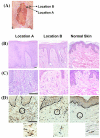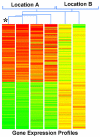Molecular markers in patients with chronic wounds to guide surgical debridement
- PMID: 17515955
- PMCID: PMC1869625
- DOI: 10.2119/2006-00054.Brem
Molecular markers in patients with chronic wounds to guide surgical debridement
Abstract
Chronic wounds, such as venous ulcers, are characterized by physiological impairments manifested by delays in healing, resulting in severe morbidity. Surgical debridement is routinely performed on chronic wounds because it stimulates healing. However, procedures are repeated many times on the same patient because, in contrast to tumor excision, there are no objective biological/molecular markers to guide the extent of debridement. To develop bioassays that can potentially guide surgical debridement, we assessed the pathogenesis of the patients' wound tissue before and after wound debridement. We obtained biopsies from three patients at two locations, the nonhealing edge (prior to debridement) and the adjacent, nonulcerated skin of the venous ulcers (post debridement), and evaluated their histology, biological response to wounding (migration) and gene expression profile. We found that biopsies from the nonhealing edges exhibit distinct pathogenic morphology (hyperproliferative/hyperkeratotic epidermis; dermal fibrosis; increased procollagen synthesis). Fibroblasts deriving from this location exhibit impaired migration in comparison to the cells from adjacent nonulcerated biopsies, which exhibit normalization of morphology and normal migration capacity. The nonhealing edges have a specific, identifiable, and reproducible gene expression profile. The adjacent nonulcerated biopsies have their own distinctive reproducible gene expression profile, signifying that particular wound areas can be identified by gene expression profiling. We conclude that chronic ulcers contain distinct subpopulations of cells with different capacity to heal and that gene expression profiling can be utilized to identify them. In the future, molecular markers will be developed to identify the nonimpaired tissue, thereby making surgical debridement more accurate and more efficacious.
Figures






References
-
- Brem H, et al. Healing of elderly patients with diabetic foot ulcers, venous stasis ulcers, and pressure ulcers. Surg Technol Int. 2003;11:161–167. - PubMed
-
- Bergan JJ, et al. Chronic venous disease. N Engl J Med. 2006;355:488–498. - PubMed
-
- Services UDoHaH. (2004) Guidance to surveyors for long term care facilities. Guidance to Surveyors for Long Term Care Facilities on World Wide Web URL: http://www.cms.hhs.gov//
-
- Steed DL, Donohoe D, Webster MW, Lindsley L Diabetic Ulcer Study Group. Effect of extensive debridement and treatment on the healing of diabetic foot ulcers. J Am Coll Surg. 1996;77:575–586. - PubMed
-
- Sibbald RG, et al. Preparing the wound bed—debridement, bacterial balance, and moisture balance. Ostomy Wound Manage. 2000;46:14–22. 24–18, 30–15. quiz 36-17. - PubMed
Publication types
MeSH terms
Substances
Grants and funding
LinkOut - more resources
Full Text Sources
Other Literature Sources
Medical
Molecular Biology Databases
